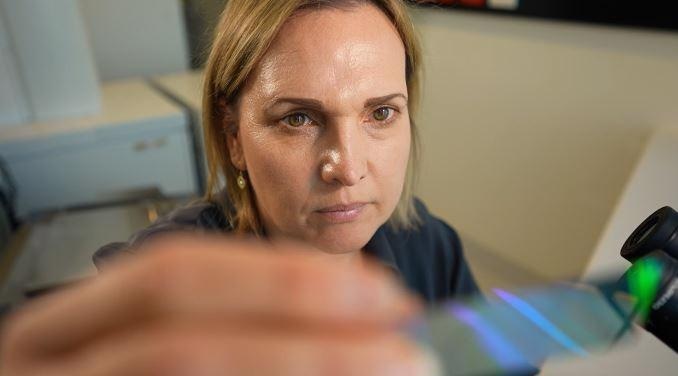A new microscope slide that can be used with any optical microscope may forever change how we identify cancer cells, according to a paper published in Nature today.
 “Looking for just a few cancer cells amongst hundreds of healthy cells is like trying to look for a needle in a haystack.” Professor Brian Abbey, La Trobe University, photo Science in Public. Image Credit: ANFF
“Looking for just a few cancer cells amongst hundreds of healthy cells is like trying to look for a needle in a haystack.” Professor Brian Abbey, La Trobe University, photo Science in Public. Image Credit: ANFF
This easy to use but powerful new tool, the NanoMslide, is the invention of two researchers at La Trobe University, Professor Brian Abbey, and Dr Eugeniu Balaur. Together with Associate Professor Belinda Parker of the Peter MacCallum Cancer Centre, they have spent the past five years developing the technology as a medical diagnostic tool for detecting cancer cells.
“For the first time I saw cancer cells just popping up at me,” said Associate Professor Parker.
“All we did was take a section of breast cancer tissue, put it on a glass slide and look at it under a conventional light microscope. And we could easily distinguish cancer cells from the surrounding normal tissue”.
“The slide also distinguishes cancer from other non-cancerous abnormalities in the breast, which has great promise for early cancer diagnosis”.
The slide incorporates layers of finely printed metals on the surface of the glass to manipulate the interaction of light with cells. The result is massively enhanced contrast when viewing tissue under the microscope. Researchers have described the difference as going from black and white television to colour.
“Looking for just a few cancer cells amongst hundreds of healthy cells is like trying to look for a needle in a haystack,” says Professor Abbey. “So, what our technology aims to do is to make this process much easier and quicker for the pathologist by identifying abnormal cancer cells from a field of thousands.”
“We developed the slide using specialist machines at the Melbourne Centre for Nanofabrication (MCN), part of the Australian National Fabrication Facility (ANFF), which provides sophisticated manufacturing solutions in specialised environments for Australia’s researchers working on developing next generation nanotechnologies.
“But until recently, we lacked a key piece of equipment,” says Professor Abbey, “meaning that we had to post our slides to Europe for additional processing.”
ANFF and La Trobe University have now invested half a million dollars to bring a key piece of equipment, the Eulitha Phabler 100C, to Australia. It provides the La Trobe team with the essential tool they need to scale up prototyping, provide proof-of-concept, and develop the product for market.
The Phabler prints high-resolution nanostructures in a low-cost photolithography (printing) system.
“Now, having that equipment here as a first in Australia, it means that we're able to carry out all of our fabrication locally, and instead of producing tens of slides we’re now able to manufacture them in the thousands.”
“We were delighted to be able to assist Brian and Eugeniu as they developed their innovative product, which will really streamline cancer diagnosis. We are sure it has a bright commercial future across the life sciences,” says Professor Nicolas Voelcker, Director for the Victorian Node of the Australian National Fabrication Facility.
Over the past 12 months, ANFF has supported more than 200 industry clients, more than 2,800 academic clients, including from ARC Centres of Excellence and several ARC Training Centres, as well as international organisations, including NASA.
“Our vision is to extend our technology to assist the diagnosis of a range of other cancers by analysing all sorts of tissue sections, as well as use in plant biology and agriculture. And now we can do it all in Melbourne,” says Professor Abbey.
Unveiling the PhableR
Video Credit: ANFF